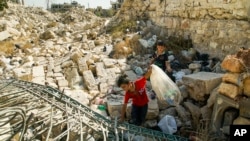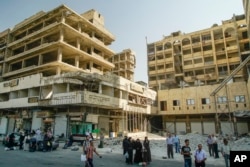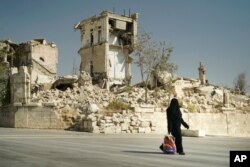"Aleppo is in my eyes," says a billboard depicting President Bashar al-Assad looking out over two men and a boy repaving the main Saadallah al-Jabiri Square — once a front line in one of the deadliest episodes of the Syrian civil war.
The recapture of eastern Aleppo in December 2016 was a landmark victory for Assad's forces in the conflict, now in its seventh year, but it left the area in ruins.
Eight months later, neighborhood after neighborhood in the formerly rebel-held sector still look like ghost towns. Only rarely is a family seen sitting on white plastic chairs outside the rubble.
Life is slowly returning to the desolate streets where shop signs are covered with dust, where men hawk cigarettes on a street corner and teenagers sell bananas off a picnic table.
Rami Abdurrahman, director of the Britain-based Syrian Observatory for Human Rights, says thousands of people have returned to their homes in Aleppo — once Syria's largest city — from camps for the displaced.
Russian troops mediating between the Syrian government and various opposition factions have helped. The task force's chief in the province, Maj. Gen. Igor Yemelyanov, said it has helped 3,500 people return to nearby villages.
Although Syrian government-controlled neighborhoods did not see the destruction and loss of life on a scale comparable to what eastern Aleppo endured, the seemingly quiet neighborhoods in the west also bear the scars of conflict.
The third floor of a school in southwestern Aleppo still has no glass after its window was blown out when a missile landed in a classroom in November 2016. Two students were killed in the classroom, and four died in a playground under the windows, principal Nakhlya Deri told reporters Tuesday during a visit arranged by the Russian Defense Ministry.
Residents have been resilient throughout, Deri insisted, describing how the school kept operating.
"After the attack, we closed down. On the following day, we cleared out the debris; and on the third day we started working," she said.
Even though the siege of Aleppo ended eight months ago, municipal services fully restored the electricity supply only last week, said provincial Gov. Hamied Kenno.
Most of the city's power plants were in eastern Aleppo, which was captured by rebels in 2012 and suffered catastrophic destruction during the battle to recapture it. For weeks after the fighting ended, electricity was cut off across the entire city, even in government-held neighborhood.
Moscow intervened in Syria two years ago to help Assad, its longtime ally. On Tuesday, the Russia military said Syrian troops have liberated about 85 percent of the country's territory from militants.
Fight against IS continues
Russian warplanes have changed the tide of the war, giving Syrian troops and allied forces an advantage over opposition fighters and militants from the Islamic State group.
Speaking to reporters at the Hemeimeem air base in Syria's Latakia province, Lt. Gen. Alexander Lapin said the Syrian government still must clear the militants from the remaining 15 percent — approximately 27,000 square kilometers (10,425 square miles).
The Syrian troops, with strong support from Iranian-backed ground forces, have in recent weeks pushed the IS militants out of central Homs province, near the border with Lebanon, and are now fighting them in the oil-rich Deir el-Zour province in the east.
Deir el-Zour is the last major IS holdout in Syria. Assad's forces, backed by Russian air power, broke a nearly 3-year-old siege on the provincial capital where troops had been encircled by the militants.
Activists said civilians are bearing the brunt of the offensive amid the intense airstrikes, with IS using them as human shields. A recent overnight airstrike hit displaced Syrians from Deir el-Zour on the western side of the Euphrates River, killing at least eight civilians.
The Observatory and Omar Abu Laila, who runs a group that monitors developments in Deir el-Zour, said Russian airstrikes were suspected.
Russian officials have denied targeting civilians there.
Russian Defense Minister Sergei Shoigu met Tuesday with Assad in the capital of Damascus and discussed measures to eliminate IS, the Russian Defense Ministry said.
Russia and Syria agreed in August 2015 for Moscow to deploy an air force contingent and other military assets at the Hemeimeem base, in the heartland of Assad's Alawite religious minority.
In a matter of weeks, Russia built up the base so it could host dozens of its warplanes. It delivered thousands of tons of military equipment and supplies by sea and cargo planes in an operation dubbed the "Syrian Express." A month later, Russia announced the launch of its air campaign in Syria, its first military action outside its borders since the collapse of the former Soviet Union.
Senior Russian military officers and special forces were deployed alongside Syrian troops, providing training, planning offensives and coordinating airstrikes. Russia has also deployed its latest weapons to the Syrian conflict, including state-of-the art Kalibr cruise missiles launched by Russian strategic bombers, surface ships and submarines, most recently in Deir el-Zour province last week.
Russia never said how many troops it sent, but turnout figures in voting from abroad in the 2016 parliamentary elections indicated Russian military personnel in Syria at the time likely exceeded 4,300. The Russian military said last week that 34 of its servicemen have been killed in Syria.











